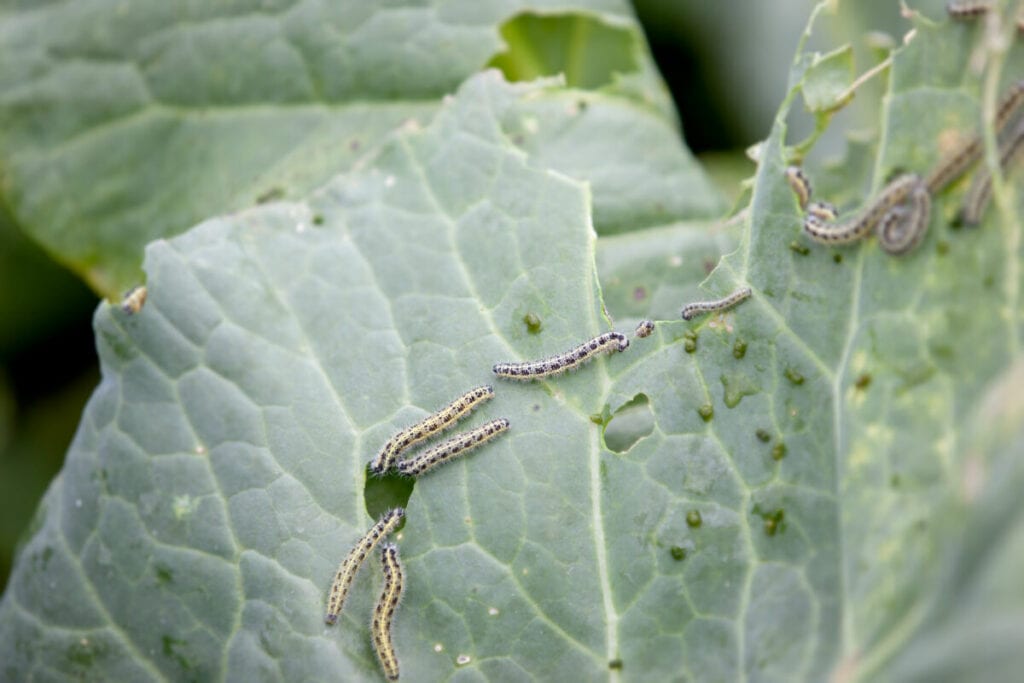Are you seeing strange, small worms crawling around the leaves of your vegetable plants? Chances are, they’re cabbage worms.
In this blog post, we’ll discuss what cabbage worms are and how to prevent them from infesting your garden. We’ll also go over the common signs of an infestation so you can take action if needed.
What are cabbage worms?
Cabbage worms are small green caterpillars with yellow stripes down their backs. They have black heads and are about an inch long when fully grown.
These pests feed on the leaves of cabbage, kale, broccoli, cauliflower, Brussels sprouts, and other related plants. The larvae will skeletonize leaves as they munch away at the plant tissue and this can cause considerable damage to crops if left unchecked.
What damage do cabbage worms cause on plants?
Young larvae will consume the tender leaves of the plant, leaving behind small, irregularly-shaped holes and tattered pieces of leaves.
As they mature, they feed on larger areas of foliage, resulting in more prominent skeletonized sections of leaves.
In severe infestations, these caterpillars can completely defoliate a plant, leaving it weakened and vulnerable to other pests or diseases.
The presence of large numbers of cabbage worms on a plant can reduce its yield and make it unappealing for harvest.
How to identify cabbage worms on plants

The main way to identify cabbage worms on your plants is to look for their distinct green color and yellow stripes down their backs. You may also find them with black heads if they are more mature. These caterpillars can range in size from 1/4 inch up to 1 inch when fully grown.
You can also spot an infestation by looking for the damage caused by the larvae feeding on the plant’s foliage. This damage is usually characterized by small, irregular holes, and tattered pieces of leaves throughout the plant. As the infestation becomes more severe, you will notice larger skeletonized sections of leaves that have been eaten away by the worms.
Read more:
How to get rid of cabbage worms
Handpicking: One of the easiest and safest ways to get rid of cabbage worms is to pick them off your plants by hand. This method can be especially effective if you catch the infestation early.
Organic Pesticides: If you need to use a pesticide, opt for an organic variety such as neem oil or spinosad. These products are safer for beneficial insects in your garden and won’t leave behind any harmful residues on your edible crops.
Insecticidal Soap: Insecticidal soaps can be an effective way to control cabbage worms. The active ingredient in insecticidal soap is potassium salts of fatty acids, which act by disrupting the membrane of the caterpillar’s cells.
Diatomaceous Earth: Diatomaceous earth is a natural product made from crushed fossils. It works by physically abrading the caterpillar’s exterior, causing it to dehydrate and eventually die.
Read more:
- How To Stop Insects Eating Plant Leaves
- How to Use Neem Oil and Save Your Plants
- How To Use Diatomaceous Earth In Potted Plants
- Insecticidal Soap vs Dish Soap for Pest Control
How to prevent cabbage worms on plants
- Cover your vegetable plants with row covers or netting if possible.
- Clean up any debris from your garden that can provide shelter for the caterpillars.
- Plant companion plants like dill, marigolds, and nasturtiums to help deter cabbage worms.
- Introduce beneficial insects such as green lacewings, ladybugs, and parasitic wasps which can feed on cabbage worms.
Host vegetable plants for cabbage worms
Cabbage worms are common pests of cabbage, kale, broccoli, cauliflower, Brussels sprouts, and other related plants.
Natural predators of cabbage worms
These predators include birds, such as thrushes and blackbirds, parasitic wasps, ladybugs, and green lacewings.
Birds will prey on both the larvae and adult stages of the cabbage worm while parasitic wasps, ladybugs, and green lacewings feed exclusively on the larvae stage.
References
- https://www.almanac.com/pest/cabbage-worms
- https://www.maine.gov/dacf/php/gotpests/bugs/cabbage-worms.htm
- https://entomology.ca.uky.edu/ef300

Fact Checked, Written, and Published by Kevin Rodrigues
Kevin is the founder of Gardening Mentor, a website that aims to teach people to grow their own food in a limited space. As a self-taught gardener, Kevin has spent several years growing plants and creating gardening content on the website. He is certified in Home Horticulture and Organic Gardening from Oregon State University. He has a Post Graduate Diploma in Horticulture and Landscape Gardening from Mumbai University.
Read more
